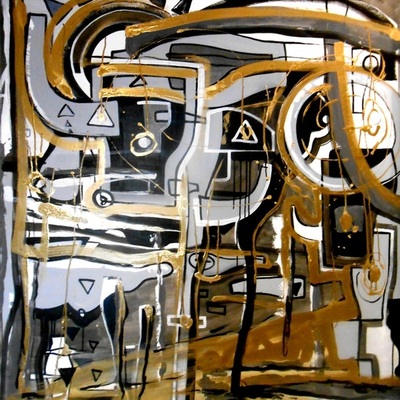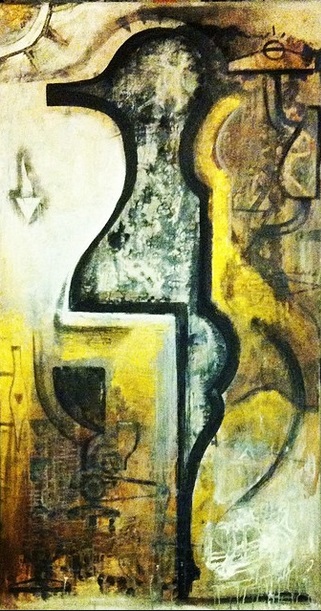Industrial Symbolism
Intertwined lines, interlaced shapes, and hybridized forms. A collection of artworks that is both extremely mechanical and exuberantly organic, composing an artistic language which dwells in darkness, as well as in a stark light made of washes of titanium white. Such is the Industrial Symbolism series of Jonatas Chimen.
Industrial because of its references to the Industrial Revolution, as an homage to the machinery which brought about great cultural, social, and economic changes at the end of the 19th century. The very palette of Chimen's Industrial Symbolism has a direct link to the energy-generating forms which became popular during the Industrial Revolution, namely; coal burning – thus the artist's heavy use of charcoal; the steam engine – where Chimen found the fogginess reference for his collection; and waterpower – seeing through the dripping paint and varnishes depicted in the series.
But one might ask: Why bring up a 19th century subject today? Jonatas Chimen does not hold an infatuation with the old, instead, he sees a contemporary parallel to the cultural revolution which occurred about two centuries ago. In the past, there was the locomotive which brought about deep cultural changes, and today, there is the highest technological advances of all times which fit within the palm of our hands, such as mobile devices, 3D printing, and augment reality. Once again, humanity's relationship with technology has been greatly transformed, capable of reshaping our kinship and the world around us, and certainly able to cause great good, as well as great evil.
This romantic idea of the transplanting, constructing, deconstructing, coding, and decoding the human being, is a subject that Jonatas Chimen revisits quite often. Like in his performance titled“...(On Self) – Awareness – A Dialogue With Artificial Intelligence…” and in his light painting series titled “The Illuminatur Project,” the artist aims to find a positive, enlightening, and greatly optimistic view of technology. But in the end, he always offers a word of caution.
As English author Mary Shelley pointed out during the times of the Industrial Revolution, reckless progress may bring about disastrous consequences. With this in mind, Shelley created one of the greatest legends of modern literature: Frankenstein; or, The Modern Prometheus. For Shelley, Frankenstein represented the extraordinary spirit of the Industrial Revolution: Humanity's search for immortality. Frankenstein represented the age of the superhuman, the era of the augment specimen, and the victory of life over death. But as Shelley's story concluded, Frankenstein's creation was calamitous.
That is the reason why Jonatas Chimen chooses to speak with much caution when it comes to the betterment of society through technology alone. And so, in his Industrial Symbolism series the artist does not advocate for the replacement of the natural with the artificial, but instead, for the seamless mingling of the organic with the technological, when necessary. Thus, Jonatas' intertwined lines, interlaced shapes, and hybridized forms, pay homage to a deep desire for true human progress. It is something that begins with the physical, but which certainly must transcend into the spiritual, in order to bring about complete healing. That is why the bulk of this collection, instead of being housed in a museum or gallery as precious objet d'art, it is permanently and prominently housed in a place of healing – The Spine Center of Hollywood, Florida.
Industrial because of its references to the Industrial Revolution, as an homage to the machinery which brought about great cultural, social, and economic changes at the end of the 19th century. The very palette of Chimen's Industrial Symbolism has a direct link to the energy-generating forms which became popular during the Industrial Revolution, namely; coal burning – thus the artist's heavy use of charcoal; the steam engine – where Chimen found the fogginess reference for his collection; and waterpower – seeing through the dripping paint and varnishes depicted in the series.
But one might ask: Why bring up a 19th century subject today? Jonatas Chimen does not hold an infatuation with the old, instead, he sees a contemporary parallel to the cultural revolution which occurred about two centuries ago. In the past, there was the locomotive which brought about deep cultural changes, and today, there is the highest technological advances of all times which fit within the palm of our hands, such as mobile devices, 3D printing, and augment reality. Once again, humanity's relationship with technology has been greatly transformed, capable of reshaping our kinship and the world around us, and certainly able to cause great good, as well as great evil.
This romantic idea of the transplanting, constructing, deconstructing, coding, and decoding the human being, is a subject that Jonatas Chimen revisits quite often. Like in his performance titled“...(On Self) – Awareness – A Dialogue With Artificial Intelligence…” and in his light painting series titled “The Illuminatur Project,” the artist aims to find a positive, enlightening, and greatly optimistic view of technology. But in the end, he always offers a word of caution.
As English author Mary Shelley pointed out during the times of the Industrial Revolution, reckless progress may bring about disastrous consequences. With this in mind, Shelley created one of the greatest legends of modern literature: Frankenstein; or, The Modern Prometheus. For Shelley, Frankenstein represented the extraordinary spirit of the Industrial Revolution: Humanity's search for immortality. Frankenstein represented the age of the superhuman, the era of the augment specimen, and the victory of life over death. But as Shelley's story concluded, Frankenstein's creation was calamitous.
That is the reason why Jonatas Chimen chooses to speak with much caution when it comes to the betterment of society through technology alone. And so, in his Industrial Symbolism series the artist does not advocate for the replacement of the natural with the artificial, but instead, for the seamless mingling of the organic with the technological, when necessary. Thus, Jonatas' intertwined lines, interlaced shapes, and hybridized forms, pay homage to a deep desire for true human progress. It is something that begins with the physical, but which certainly must transcend into the spiritual, in order to bring about complete healing. That is why the bulk of this collection, instead of being housed in a museum or gallery as precious objet d'art, it is permanently and prominently housed in a place of healing – The Spine Center of Hollywood, Florida.











